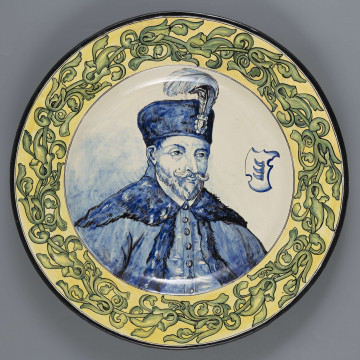
Stephen Báthory - royal entourage
1792 — 1797
National Museum in Lublin
Part of the collection: Polish medallic art.
The second half of the 16th century was the time when Polish medallists came to the fore in the Commonwealth. They were most often anonymous artists. There is much to suggest that they were associated with mints operating in the Kingdom of Poland and the Grand Duchy of Lithuania. A distinctive feature of this period, apart from the increasingly frequent appearance of early Baroque motifs, is the minting of medals, as opposed to the previously used casting technique. It was mainly due to the progress in minting and introduction of more and more perfect machines. The willingness to imitate the models from Western Europe was also significant. Although minters of that time were mainly craftsmen, many of them had artistic flair, which they tried to use in medal-making. The mint in Vilnius, which was very active at that time, gained particular importance in this respect. During the reign of Stefan Batory, Vilnius in a sense took over the functions of the capital city of Krakow. This was the result of the king's involvement in the war with Moscow, and later setting order in Livonia, which had been incorporated into the Commonwealth. For this reason the king spent a lot of time in the capital of the Grand Duchy of Lithuania, which was conducive to the city's development, including artistic revival. There are at least two medals related to the figure of Stefan Batory which can be traced back to the Lithuanian mint in Vilnius. One of them is the presented oval medal, which was struck to commemorate the victorious Moscow campaign of 1577-1582. As a result of the treaty signed at Jama Zapolska, Livonia and Polotsk were incorporated into the Commonwealth. An inscription on the reverse of the medal informs us that it was struck in 1582. On the obverse side, the ruler's facial features are rendered very carefully and realistically.
This medal, like many other Polish historical medals, was eagerly copied, especially in the 19th century. That is why today we can often come across such copies. They were made with the casting technique, and the copies obtained in this way sometimes differ slightly from the original, either in dimensions or in the accuracy of depiction. The presented medal is also a copy made in brass at an unknown time.
Leszek Poniewozik
Author / creator
Dimensions
cały obiekt: height: 35 mm, width: 41 mm
Object type
medal
Technique
cast
Material
brass
Creation time / dating
Creation / finding place
Owner
The National Museum in Lublin
Identification number
Location / status

1792 — 1797
National Museum in Lublin

1882 — 1885
National Museum in Lublin

National Museum in Lublin
DISCOVER this TOPIC
National Museum in Lublin
DISCOVER this PATH
Educational path